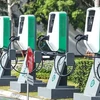
Hanoi (VNA) – With a high digital economic growth rate of about 20% per year, and the fastest rise in e-commerce in the ASEAN region, Vietnam is moving close to the position of top three biggest countries in the ASEAN region in terms of its digital economy.
Vietnam has set a target of raising the contribution to the country’s GDP to 20% by 2025 and 30% five years later, with the proportion of digital economy in each industry and field reaching at least 10% by 2025 and doubling by 2030.
According to Tran Minh Tuan, Director of the Digital Economy and Digital Society Department under the Ministry of Information and Communications (MIC), in the 2000s, the concept of the digital economy focused only on the information and communications technology (ICT) industry. Now, it continues to spread to all industries and fields.
Tuan cited data from the MIC showing that by 2023, it accounted for about 16.5% of GDP, of which ICT industry made up nearly 60%.
International organisations assessed that Vietnam's digital economic growth rate is high at about 20% per year, three times the GDP growth rate. Particularly, Vietnam leads the ASEAN countries in the growth pace of e-commerce.
Vietnamese people's absorption into digital economic fields is increasing, pushing the country close to the position among the top 3 in the ASEAN region, said Tuan.
Hoang Viet Tien, Deputy Secretary of the Vietnam Digital Communication Association, said that Vietnam's Internet has gone through many stages of development, with digital transformation, especially in the development of AI in the next few years predicted to boom. Tien stressed the need for foundation and solutions to support the development of the infrastructure.
By now, the MIC has licensed three telecommunications service suppliers to launch 5G services. In the coming period, to successfully implement digital transformation and digital infrastructure, providers need to work out user-friendly solutions, Tien said, adding that State management agencies should issue appropriate decrees, circulars, and instructions.
Ericsson Vietnam estimated that 5G will account for about 50% of Vietnam's mobile subscribers by 2029. Currently, more than 25% of the data traffic is transmitted via 5G.
President and CEO of Ericsson Vietnam Rita Mokbel said that with its global experience and leadership in 5G deployment, Ericsson is ready to support its commercialisation in Vietnam. Ericsson is currently working closely with local operators and enterprises to develop use cases tailored to Vietnam's specific needs, she said.
Meanwhile, Eric Yeo, Country Manager for Amazon Web Services Vietnam, said that his firm wants to cooperate with Vietnamese telecommunications operators to provide technology, expertise, and experience in building infrastructure and improving the skills of the workforce, helping telecommunications operators maximise profits from 5G investment.
Nguyen Tuan Huy, head of the Digital Tranformation Department of MobiFone, said that the overal goal of digital transformation is to improve business efficiency, increase labour productivity, and work performance, and to enhance service quality for customers.
Digital transformation is not simply the use of digital technology in socioeconomic activities but also the process of establishing a new, advanced, and modern production method, in which AI, IOT, Big Data, and Cloud are important production tools in a variety of industries and fields, he stated./.






















